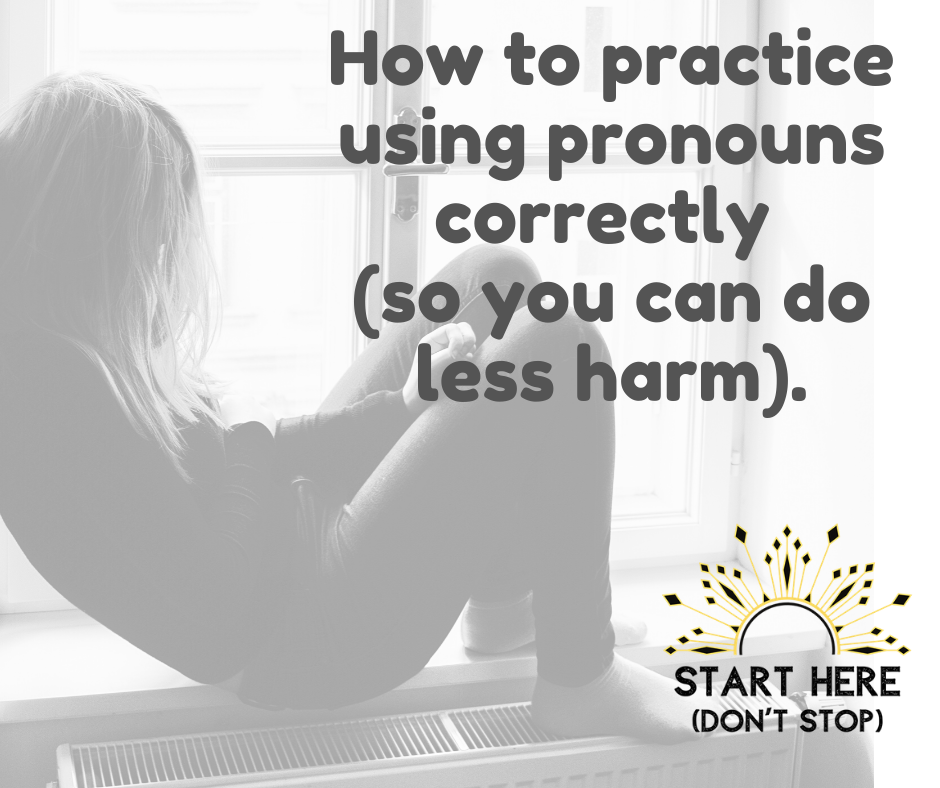How to practice using pronouns correctly (so you can do less harm)

At the end of the only explanation of pronouns you’ll ever need, I promised to offer some simple guidance on how to practice using pronouns correctly. I trust that if you’re reading this, you 1) are a good person and 2) want to minimize the amount of harm you’re doing in the world. Since I’ve been down this path and still have to be very mindful of using correct pronouns, I thought I’d share some things that I’ve found especially helpful.
- See the problem for what it is: it’s more than a language shift.
Most people reading this have been, like me, raised in societies that have not historically been kind to people who fall outside dominant cultural norms—whether those are norms related to race, class, gender, ability, immigration status, spiritual beliefs… the list goes on. Since that is the reality we’re swimming in every day, it takes a commitment to ongoing work to rise above these messages that we’ve been acculturated to since birth. - Realize that your assumptions are just that.
A deep voice, crewcut hair, bright floral colors, dresses, makeup, jewelry, large trucks, power tools… Odds are that as you read through that, a specific gender came to mind for each, whether you were conscious of it or not. But these associations that we have are things we’ve been taught. None of these things actually belong to any particular gender. But that doesn’t mean that it’s easy to stop making those snap associations. - Actively work to avoid making assumptions.
Regardless of someone’s voice, height, body shape, clothing, mannerisms, hair style, etc., work to stop making assumptions about their gender. We’re taught from infancy to see gender (but only two of them) and skin color (but only if it is other than white) first. We have to make a commitment to check that all day every day. - Reduce the use of gendered language in general—and thus opportunities for error.
When I took up this challenge, I was surprised at how relatively easy it was to do and how helpful it has been. It will no doubt be easier for some folks reading this than others, but it’s one of the single most effective things you can do in order to stop misgendering people. Just look for every opportunity to omit gendered words like guys, dude, ladies, man, etc. from your vocabulary unless you know they are true for each and every person you’re referring to. (Stay tuned for an upcoming post with specifics on this!) - Commit to using someone’s correct pronouns—or no pronouns at all.
When you do have to use pronouns for someone whose pronouns you don’t yet know, consider something like my workplace is doing: the agreement is that for everyone—staff, clients, partners, etc.—we use they/them pronouns for everyone until we know their actual pronouns. Once we know their pronouns, we use those. - Understand that the myth of there being only two genders is relatively new and concentrated within white, western, Christian-dominated cultures.
Capitalist patriarchy is deeply and desperately invested in the myth of only two genders who pair up as “straight” couples. But “on nearly every continent, and for all of recorded history, thriving cultures have recognized, revered, and integrated more than two genders” and “hundreds of distinct societies around the globe have their own long-established traditions for third, fourth, fifth, or more genders” (PBS). The current obsession with the mythical gender binary is out of step with history and out of touch with science and objective reality. - Practice, practice, practice using personal pronouns you’re trying to do better with.
I’ve heard adorable stories of friend groups and families having practice sessions where they would sit and practice using the pronouns of a loved one who was coming to visit who had recently started using pronouns they were not used to using—perhaps by sharing sweet stories, etc. (“I remember one time when… they came over with… their new puppy to cheer me up. I thought that was so sweet of… them!) - Above all, make sure your heart is in it.
We’ve probably all heard phrases about “putting your mind to something,” but I want to invite you to put your heart to this. If you’ve gotten this far, I think it’s safe to say that you don’t want to disrespect people or do harm that can be avoided. So rather than make it a cerebral undertaking, put your heart to this and you’ll make faster and longer-lasting progress. I promise.
Stay tuned for more goodness—and please get in touch with thoughts, questions, suggestions and feedback!